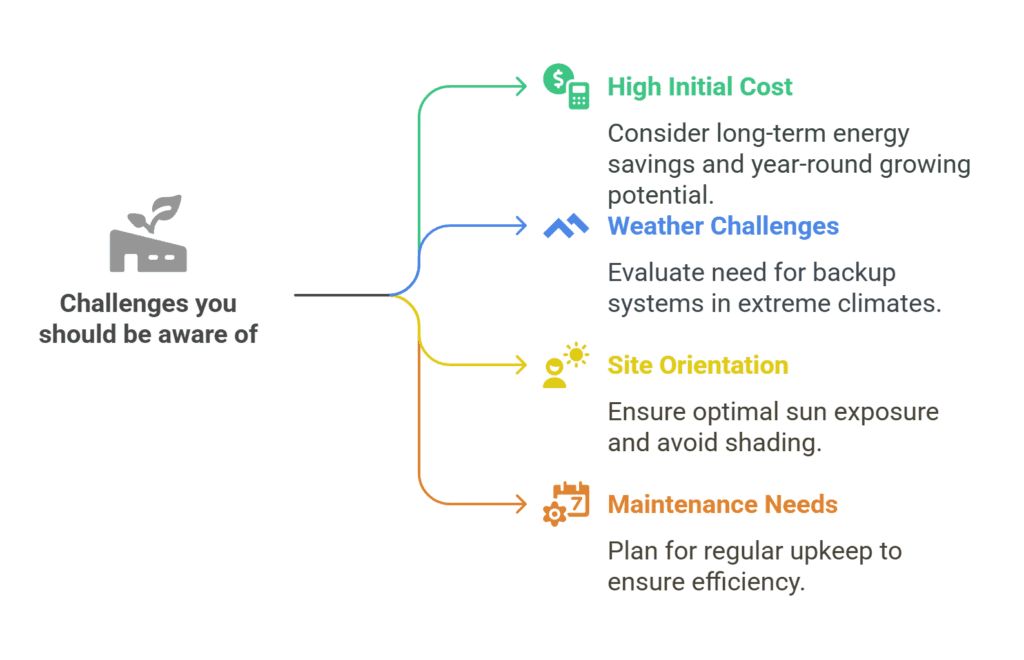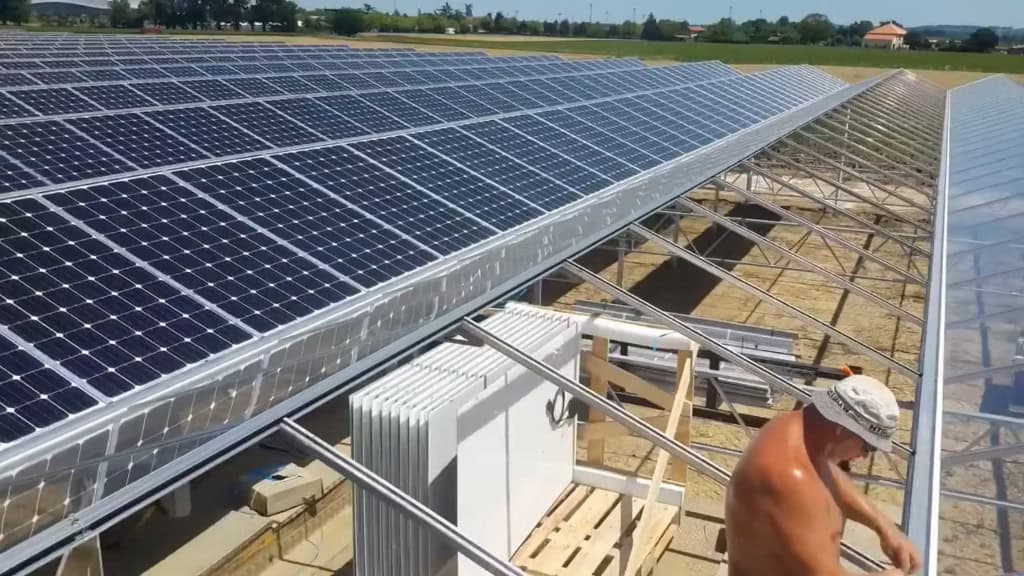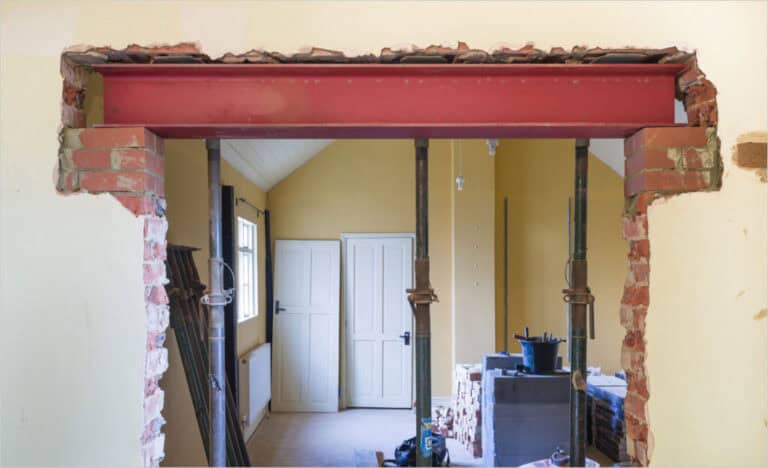Rising energy costs, unpredictable weather, and the push for sustainable farming have many growers asking a simple question: Is a solar greenhouse worth it?
Unlike conventional greenhouses, solar greenhouses are designed to collect, store, and manage solar energy—offering the promise of year-round growing with minimal external heating. But are the benefits as clear-cut as they sound? And what are the hidden trade-offs?
In this article, we break down the real pros and cons of solar greenhouses, backed by practical insights, common design pitfalls, and real-world examples. Whether you’re planning a small homestead setup or exploring commercial solutions, this guide will help you decide if a solar greenhouse is the right move for you.
What to Expect in This Blog:
What Is a Solar Greenhouse and How Does It Work?
A solar greenhouse is a type of greenhouse that uses solar energy as its main heat source. Unlike traditional greenhouses, which often rely on gas or electric heaters in cold seasons, solar greenhouses are designed to trap, store, and distribute solar heat efficiently.
There are two main types: passive and active.
- A passive solar greenhouse uses smart design—like south-facing orientation, thermal mass (such as water barrels or concrete), and insulation—to capture and hold heat during the day and release it at night.
- An active solar greenhouse goes a step further. It may use solar panels, solar-powered fans, or thermal storage systems to better control temperature and airflow.
In both cases, the goal is the same: maintain a stable growing environment while reducing energy input.
If you’re thinking about building a greenhouse that works year-round, especially in colder regions or off-grid areas, a solar greenhouse might be exactly what you need. But as with any system, it comes with both benefits and trade-offs—which we’ll explore next.
Further Reading:
What is a Solar Greenhouse? Do You Really Know?
What Makes Solar Greenhouses Worth Considering?
If you’re exploring whether a solar greenhouse is a smart investment, it helps to start with the key advantages. These systems offer more than just “free sunlight”—they can reshape how you grow crops, manage energy, and reduce your footprint.
Can It Really Lower Your Energy Bills?
Yes—this is one of the biggest reasons people switch to solar greenhouses.
Traditional greenhouses often rely on gas or electric heaters, especially in winter. Solar greenhouses are built to maximize passive heat gain, using the sun as the main source of warmth. Some systems even include solar panels to power fans, lighting, or automated controls.
The result? Lower operating costs, especially over time.
Does It Allow Year-Round Growing?
In cold or temperate climates, a well-designed solar greenhouse can extend or even enable year-round growing. By holding onto heat during the day and releasing it at night, it keeps temperatures stable—without the need for constant heating.
This is especially useful for leafy greens, herbs, and other cool-season crops.
Is It an Eco-Friendly Growing Solution?
Absolutely. Solar greenhouses reduce your dependence on fossil fuels and electricity. That means lower emissions and a smaller carbon footprint—a big plus for anyone aiming for sustainable farming or organic certification.
They also support off-grid or low-infrastructure setups, making them ideal for eco-farms or permaculture projects.
Is It Suitable for Remote or Low-Infrastructure Areas?
Because they don’t require constant external power, solar greenhouses work well in rural, remote, or off-grid locations. Whether you’re managing a small homestead or supporting food production in isolated regions, solar systems offer both independence and reliability.
Can You Achieve Better Control Over the Growing Environment?
Yes, especially with passive solar designs. By combining thermal mass, insulation, and strategic orientation, you can create a more stable internal climate. That means fewer temperature swings, better humidity retention, and less risk of stress on your crops.
This kind of climate stability is crucial for sensitive plants and consistent production quality.
Is It a Smart Long-Term Investment?
While a solar greenhouse may cost more upfront than a basic plastic tunnel, the long-term savings often outweigh the initial expense. Lower energy bills, reduced reliance on heating systems, and minimal maintenance all add up.
If you’re thinking long-term—especially over 5 to 10 years—a solar greenhouse can offer strong ROI and more predictable costs.
What Challenges Should You Be Aware Of?
No system is perfect—including solar greenhouses. While the benefits are real, it’s important to know where the limitations lie. Understanding the potential downsides will help you plan better—and avoid disappointment later on.

Is It Expensive to Build?
Yes, the initial cost can be a barrier for some growers. Compared to a basic plastic tunnel or conventional greenhouse, a solar greenhouse usually requires:
- Better insulation materials
- Thoughtful design and orientation
- Possibly solar panels, fans, or batteries
But don’t write it off too quickly. Over time, the energy savings can offset the upfront investment—especially if you plan to grow year-round or in extreme climates.
Does It Struggle in Harsh Weather?
Sometimes, yes. While solar greenhouses are designed to regulate heat, extreme climates can push the limits.
- In very hot areas, they may overheat without proper ventilation.
- In extremely cold regions, passive heat alone may not be enough during long cloudy periods.
This is why local climate and design go hand in hand. If you’re in a challenging zone, you may need backup systems—like shade covers or supplemental heaters.
Does Site Orientation Really Matter That Much?
Absolutely. A solar greenhouse needs to face the sun, usually south in the northern hemisphere. It also needs to avoid shading from trees, buildings, or slopes.
This means you can’t just put it “where there’s space.” You need to plan carefully. Poor orientation will waste solar gain—and reduce the system’s overall efficiency.
Are There Ongoing Maintenance Needs?
Yes, though they’re manageable. Most solar greenhouses are low-maintenance once built, but you’ll still need to:
- Clean solar panels for maximum output
- Check vents, seals, and insulation regularly
- Maintain batteries or solar controllers if you use them
Like any agricultural system, preventive maintenance is key to long-term performance.
Solar greenhouses aren’t plug-and-play. They need planning, smart design, and occasional upkeep. But if you’re aware of the challenges from the start, they won’t come as surprises—and many can be addressed before construction even begins.
What Should You Consider Before Building One?
If you’re seriously thinking about building a solar greenhouse, there are a few important questions to ask before moving forward. These considerations will shape not just your design—but also your results.

Should You Combine Solar with Other Systems?
In many cases, yes. While passive solar features can go a long way, they’re not always enough—especially in very hot or very cold climates.
Some growers use hybrid setups, combining solar design with:
- Ventilation fans (solar-powered or manual)
- Backup heaters (used only during cold snaps)
- Automatic shading or irrigation systems
This gives you more control and reduces risk, especially if you’re growing high-value crops or aiming for year-round production.
What Materials Work Best for Structure and Insulation?
Material choice affects both performance and lifespan.
- For framing, steel is a strong choice. It’s durable, weather-resistant, and ideal for integrating solar panels or automation systems.
- For insulation and glazing, look for polycarbonate, double-pane glass, or other high-performance materials that balance heat retention and light transmission.
- Don’t overlook thermal mass—such as water barrels or stone flooring—to store and slowly release heat.
A well-designed structure isn’t just about standing strong—it’s about regulating heat effectively, season after season.
Is It Viable for Commercial Use?
It can be, but you need to run the numbers.
For small-scale growers, a solar greenhouse can reduce operating costs and extend the growing season. For commercial farms, ROI depends on:
- Crop selection (e.g. herbs, greens, seedlings, mushrooms)
- Local climate and energy prices
- Initial investment and available subsidies
- Labor and maintenance requirements
If you’re targeting high-margin crops or want to cut fuel bills long term, solar greenhouses can be a solid investment. Just make sure to model your costs and yields realistically.
Building a solar greenhouse isn’t just about going green—it’s about making smart decisions that fit your land, your climate, and your goals. Planning well at the start makes all the difference in the end.
Common Pitfalls When Building a Solar Greenhouse (And How to Avoid Them)
Even with a great concept, a solar greenhouse can underperform—or fail—if a few key mistakes aren’t avoided early on. Here are some common pitfalls we’ve seen, and how to plan around them.
Ignoring Orientation and Sun Exposure
This is one of the most common mistakes. Solar greenhouses rely heavily on direct sunlight, especially in winter. If your greenhouse isn’t properly oriented—usually facing true south (in the northern hemisphere)—you’ll lose heat gain where it matters most.
Also, even partial shading from trees, nearby structures, or terrain can dramatically reduce performance.
Tip: Plan your site carefully. Use a sun path diagram or simple observation to ensure your greenhouse gets maximum sun, especially from late morning to early afternoon.
Underestimating Insulation and Thermal Mass
Many people think sunlight alone is enough. It’s not. Without proper insulation and thermal mass, most of the heat gained during the day is lost quickly after sunset—especially in winter.
Tip:
- Insulate north-facing walls and the foundation.
- Use water barrels, brick walls, or concrete flooring to store daytime heat and release it at night.
- Double-layer glazing (like twin-wall polycarbonate) helps trap heat more effectively.
Overcomplicating the System Too Early
Trying to install every possible feature—solar panels, battery storage, auto-controls, backup heating—at once can lead to unnecessary cost and complexity, especially if you’re just starting out.
Tip: Start with a solid passive design. Once you understand your climate and growing rhythm, then gradually add features based on real needs.
Choosing the Wrong Materials for Your Climate
Materials that work well in one region may fail in another. For example, cheap plastic sheeting might not survive heavy snow or strong UV exposure, and untreated wood may rot in humid areas.
Tip:
- In humid or coastal climates, go for steel structures and rust-resistant components.
- In snowy regions, use strong framing and steep roof angles.
- Think long-term: durability and performance are more important than saving upfront.
These aren’t just technical details—they’re the things that determine whether your solar greenhouse will thrive for years or leave you frustrated after one season. Plan ahead, and most of these issues can be avoided entirely.
Real-World Examples: How Are Solar Greenhouses Used Around the World?
Solar greenhouses aren’t just a theory—they’ve been applied in many parts of the world to solve real climate and energy challenges. While every project is unique, some patterns are emerging based on common success stories in the field.
The following examples are based on real-world applications and widely observed practices in the solar greenhouse industry.
Case 1: Passive Solar Greenhouse in a Cold Mountain Climate
In high-altitude, snowy regions—like parts of Colorado or Central Asia—growers face long winters and sub-zero nights. Some small farms have built passive solar greenhouses using:
- South-facing polycarbonate glazing
- Insulated north walls with thermal mass (e.g., water barrels or stone)
- Simple steel frames for durability and panel support
Outcome: Even with outside temperatures well below freezing, inside conditions stay stable enough for hardy greens, without electric heaters.
Case 2: Low-Cost Greenhouse for Community Use in Temperate Zones
In many rural or educational settings, groups have developed solar greenhouses that focus on low-cost construction and basic passive heating.
Typical features include:
- Local recycled materials for the frame
- Minimal use of automation
- Clear focus on insulation and airflow control
Outcome: These projects help schools and small communities extend their growing season and reduce food insecurity, even on tight budgets.
Case 3: Off-Grid Growing in Harsh Northern Climates
In extremely cold areas—like parts of Northern Canada or Inner Mongolia—off-grid growers often combine earth-bermed construction with passive solar features.
Common elements:
- Semi-underground layout to use geothermal insulation
- Roof and glazing angled to maximize low winter sun
- No active heating, but optimized passive heat capture and retention
Outcome: Growers report high winter efficiency with almost no fossil fuel input, making these designs ideal for remote or eco-conscious operations.
What Can We Learn from These Patterns?
- Passive solar greenhouses can be adapted to very different climates
- Key success factors include smart orientation, insulation, and material choice
- Steel and polycarbonate are often preferred for their durability and integration potential
- You don’t need high-tech systems—but you do need a strategy
Whether you’re off-grid or just looking to lower heating costs, the right solar greenhouse design can make year-round growing a reality.
Conclusion: Is a Solar Greenhouse the Right Move for You?
A solar greenhouse isn’t just a structure—it’s a strategy.
Throughout this article, you’ve seen what it offers: lower energy bills, year-round productivity, reduced carbon impact, and resilience in remote or challenging environments. You’ve also seen what it demands: smart design, upfront planning, and a willingness to think beyond conventional greenhouse models.
But here’s the real takeaway:
When designed right, a solar greenhouse doesn’t just grow plants—it grows independence.
It gives you control over climate, costs, and sustainability in ways that traditional systems rarely do.
If you’re planning for the next five or ten years—not just the next season—then maybe the question isn’t “Why build a solar greenhouse?”Maybe it’s “Why wouldn’t you?”

